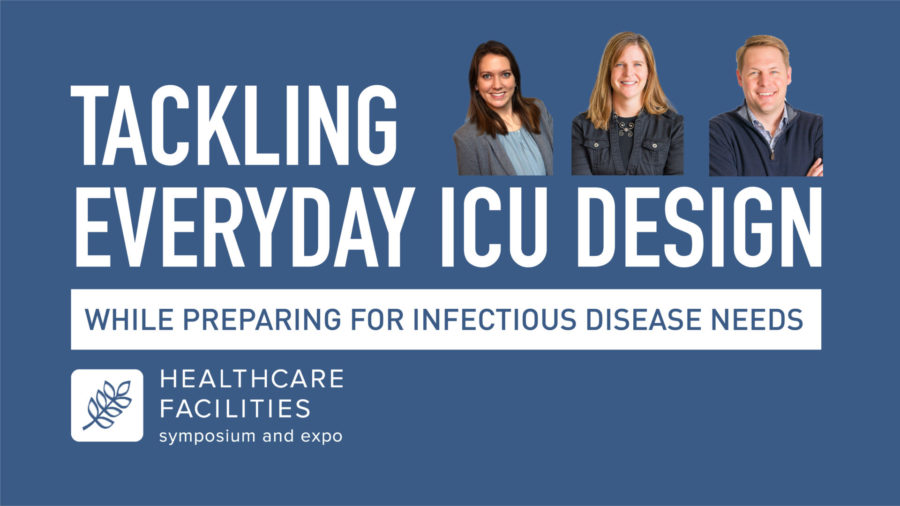Insights
Jan 24, 2022 _ insights
Preparing for Pandemics While Tackling Everyday ICU Design Challenges
The last couple of years have seen healthcare organizations quickly adopting a wide array of spatial strategies to maintain normal ICU operations during an evolving pandemic.
At the same time, GBBN was working with UK HealthCare to design a new Medical Intensive Care Unit (MICU) at the UK Albert B. Chandler Hospital. Given the amount of ad hoc experimentation that was happening around the country, our designers undertook an extensive research process to understand what was working and what wasn’t so we could integrate those insights into the design of UK HealthCare’s MICU and develop a playbook of design strategies for advancing ICU staff and patient safety.
Along with Angela Powell, PE (Senior Project Manager at UK HealthCare), GBBN’s Stephanie Shroyer, Jason Groneck, and I presented our research process and design thinking at the Healthcare Facilities Symposium and Expo.
Here are some of the highlights from that presentation:
- Though varied, the design solutions we saw working in ICUs across the country—and we developed for UK HealthCare’s MICU—stress flexibility for daily use and future mass casualty events, such as pandemics and natural disasters.
- Hot Zones. We discussed effective grouping and sequencing of “Hot Zone” program elements for serious communicable diseases, which would provide an efficient way of creating safe separations of patients with especially contagious diseases from others through physical separation, negative pressure anterooms, doffing/donning space, storage, and a Serious Communicable Disease Lab.
- Flexible Corridor. We discussed the advantage of creating wider, more flexible ICU corridors. By extending the UK HealthCare MICU corridors beyond the typical eight feet, we were able to create multipurpose spaces that allow for circulation, storage and staging space, and flexible caregiver workspace just outside of patient rooms. Part of the value of this is that care activities (prepping for minor procedures, changing IV pumps, etc.) can be done without coming into direct contact with highly infectious patients.
You can view our full presentation here.
Want to learn more about our work with UK HealthCare? Visit our case study on the UK HealthCare, Kentucky Children’s Neonatal Intensive Care Unit.
Want to learn more about GBBN’s perspective on healthcare design? Read our insights on “The Pandemic’s Impact on the Future of Healthcare Design,” “Beyond the Pandemic: A Long-term View of Healthcare Environments’ ‘New Normal,’” or “A Healing State of Mind: Salutogenesis & Stress in Cancer Care Environments.”
 Past chair of AIA Minnesota’s Health Design Knowledge Community, Kirsten Miller is an Architect and Medical Planner whose research explores ICU design, therapeutic landscapes, staff respite spaces, and oncology environments. A frequent conference presenter, her work has been published in Healthcare Design and The Journal of Therapeutic Horticulture.
Past chair of AIA Minnesota’s Health Design Knowledge Community, Kirsten Miller is an Architect and Medical Planner whose research explores ICU design, therapeutic landscapes, staff respite spaces, and oncology environments. A frequent conference presenter, her work has been published in Healthcare Design and The Journal of Therapeutic Horticulture.
 As an interior designer and medical planner, Stephanie Shroyer uses design to envelope people in environments that positively impact our mood and sense of well-being. Steph combines research, evidence-based design, and cues from nature to craft healthcare facilities that help the healing process. Recent projects include TriHealth’s Thomas Comprehensive Care Center, UK HealthCare’s Kentucky Neuroscience Institute, and UK HealthCare MICU.
As an interior designer and medical planner, Stephanie Shroyer uses design to envelope people in environments that positively impact our mood and sense of well-being. Steph combines research, evidence-based design, and cues from nature to craft healthcare facilities that help the healing process. Recent projects include TriHealth’s Thomas Comprehensive Care Center, UK HealthCare’s Kentucky Neuroscience Institute, and UK HealthCare MICU.
 While overseeing operations of GBBN’s Louisville office, Jason Groneck helps organizations see their future and create strategic spaces where people want to be. His communication skills, collaborative nature, and leadership guide all phases of a diverse range of projects, including spaces for Bon Secours Mercy Health, the Jewish Community of Louisville, and the Novak Center for Children’s Health.
While overseeing operations of GBBN’s Louisville office, Jason Groneck helps organizations see their future and create strategic spaces where people want to be. His communication skills, collaborative nature, and leadership guide all phases of a diverse range of projects, including spaces for Bon Secours Mercy Health, the Jewish Community of Louisville, and the Novak Center for Children’s Health.




